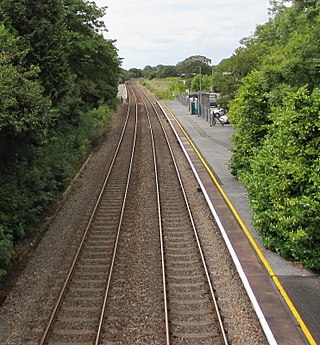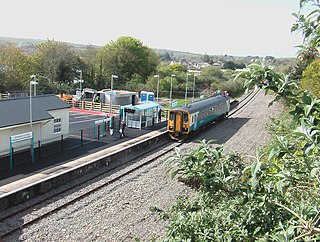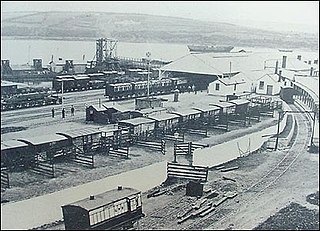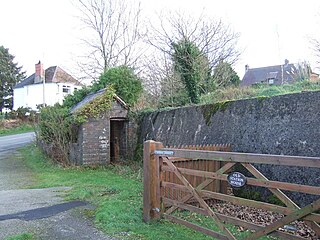History

The Great Western Railway (GWR) originally obtained access to Ireland over the South Wales Railway, which ran via Clunderwen, Clarbeston Road and Haverfordwest to Neyland, where a small port was built as part of the railway facilities; the line was opened as far as Haverfordwest in 1854, and extended to Neyland in 1856. [1]
The original proposal of 1844 (authorised by Act of Parliament in 1845) had been for the western terminus to be at Fishguard, with Haverfordwest on a branch, and by August 1847 work was in progress within 7 miles (11 km) of Fishguard. In 1848, the effects of the Great Irish Famine made Ireland a less attractive proposition, and work on the western end of the line stopped as a result. [2] In 1851, work restarted, but it was decided that the western terminus should be on the Milford Haven Waterway, and Neyland was selected; the section between Clarbeston Road and Fishguard, some 14 miles (23 km) in length, was not built. [3]
In 1878, the Rosebush and Fishguard Railway (R&FR) was formed, to extend the Narberth Road and Maenclochog Railway (NR&MR), which had opened in 1876, to Fishguard; the R&FR bought the NR&MR in 1881 and was renamed the North Pembrokeshire and Fishguard Railway (NP&FR) in 1884, although it only opened approximately 1 mile (1.6 km) of new line. [4] The NP&FR was acquired by the Fishguard and Rosslare Railways and Harbours Co. (F&RR&H) in 1894. [5] In 1899, the F&RR&H sold its railways in Wales to the GWR, which completed the extension of the NP&FR line to Fishguard and Goodwick on 1 July 1899. [6]
A new double-track line was proposed by the GWR to shorten the distance to Fishguard; this was the Clarbeston Road and Letterston Railway, which opened on 30 August 1906 between Clarbeston Junction (271 miles 8 chains (436.3 km) from Paddington) and Letterston Junction (281 miles 58 chains (453.4 km)). Prior to this, Letterston Junction was 283 miles 30 chains (456.0 km) from Paddington via Rosebush. [7] There is one tunnel, Spittal Tunnel, which is 243 yards (222 m) long; the eastern end is 274 miles 40 chains (441.8 km) from Paddington. [7] There were no intermediate stations at first, [8] but three were opened later: Wolf's Castle Halt on 1 October 1913, [9] Welsh Hook Halt on 5 May 1924, [10] and Mathry Road on 1 August 1923. [11]
The intermediate stations were closed on 6 April 1964, [12] but the line remains open for services to Fishguard & Goodwick and Fishguard Harbour stations. Falling traffic on the line caused it to be reduced to single-track on 16 May 1971 with a passing loop at Letterston Junction. [7]















